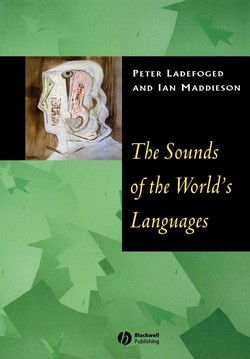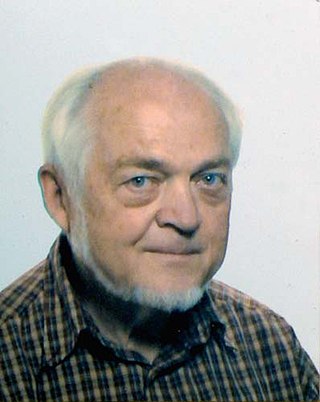Related Research Articles
Approximants are speech sounds that involve the articulators approaching each other but not narrowly enough nor with enough articulatory precision to create turbulent airflow. Therefore, approximants fall between fricatives, which do produce a turbulent airstream, and vowels, which produce no turbulence. This class is composed of sounds like and semivowels like and, as well as lateral approximants like.
In phonology and linguistics, a phoneme is a unit of sound that can distinguish one word from another in a particular language.
Phonetics is a branch of linguistics that studies how humans produce and perceive sounds, or in the case of sign languages, the equivalent aspects of sign. Linguists who specialize in studying the physical properties of speech are phoneticians. The field of phonetics is traditionally divided into three sub-disciplines based on the research questions involved such as how humans plan and execute movements to produce speech, how various movements affect the properties of the resulting sound, or how humans convert sound waves to linguistic information. Traditionally, the minimal linguistic unit of phonetics is the phone—a speech sound in a language which differs from the phonological unit of phoneme; the phoneme is an abstract categorization of phones, and it is also defined as the smallest unit that discerns meaning between sounds in any given language.
Phonology is the branch of linguistics that studies how languages or dialects systematically organize their sounds or, for sign languages, their constituent parts of signs. The term can also refer specifically to the sound or sign system of a particular language variety. At one time, the study of phonology related only to the study of the systems of phonemes in spoken languages, but may now relate to any linguistic analysis either:
Assimilation is a sound change in which some phonemes change to become more similar to other nearby sounds. A common type of phonological process across languages, assimilation can occur either within a word or between words.
A nasal vowel is a vowel that is produced with a lowering of the soft palate so that the air flow escapes through the nose and the mouth simultaneously, as in the French vowel /ɑ̃/ (help·info) or Amoy []. By contrast, oral vowels are produced without nasalization.
In phonetics, nasalization is the production of a sound while the velum is lowered, so that some air escapes through the nose during the production of the sound by the mouth. An archetypal nasal sound is.
In linguistics, a segment is "any discrete unit that can be identified, either physically or auditorily, in the stream of speech". The term is most used in phonetics and phonology to refer to the smallest elements in a language, and this usage can be synonymous with the term phone.
Prenasalized consonants are phonetic sequences of a nasal and an obstruent that behave phonologically like single consonants. The primary reason for considering them to be single consonants, rather than clusters as in English finger or member, lies in their behaviour; however, there may also be phonetic correlates which distinguish prenasalized consonants from clusters. Because of the additional difficulty in both articulation and timing, prenasalized fricatives and sonorants are not as common as prenasalized stops or affricates, and the presence of the former implies the latter.

The Sounds of the World's Languages, sometimes abbreviated SOWL, is a 1996 book by Peter Ladefoged and Ian Maddieson which documents a global survey of the sound patterns of natural languages. Drawing from the authors' own fieldwork and experiments as well as existing literature, it provides an articulatory and acoustic description of vowels and consonants from more than 300 languages. It is a prominent reference work in the field of phonetics.
Patricia Ann Keating is an American linguist and noted phonetician. She is distinguished research professor emeritus at UCLA.
In phonetics and phonology, an alveolar stop is a type of consonantal sound, made with the tongue in contact with the alveolar ridge located just behind the teeth, held tightly enough to block the passage of air. The most common sounds are the stops and, as in English toe and doe, and the voiced nasal. The 2-D finite element mode of the front part of the midsagittal tongue can stimulate the air pressed release of an alveolar stop. Alveolar consonants in children's productions have generally been demonstrated to undergo smaller vowel-related coarticulatory effects than labial and velar consonants, thus yielding consonant-specific patterns similar to those observed in adults.
Catherine Phebe Browman was an American linguist and speech scientist. She received her Ph.D. in linguistics from the University of California, Los Angeles (UCLA) in 1978. Browman was a research scientist at Bell Laboratories in New Jersey (1967–1972). While at Bell Laboratories, she was known for her work on speech synthesis using demisyllables. She later worked as researcher at Haskins Laboratories in New Haven, Connecticut (1982–1998). She was best known for developing, with Louis Goldstein, of the theory of articulatory phonology, a gesture-based approach to phonological and phonetic structure. The theoretical approach is incorporated in a computational model that generates speech from a gesturally-specified lexicon. Browman was made an honorary member of the Association for Laboratory Phonology.
Mary Esther Beckman is a Professor Emerita of Linguistics at the Ohio State University.
Hypocorrection is a sociolinguistic phenomenon that involves the purposeful addition of slang or a shift in pronunciation, word form, or grammatical construction and is propelled by a desire to appear less intelligible or to strike rapport. That contrasts with hesitation and modulation because rather than not having the right words to say or choosing to avoid them, the speaker chooses to adopt a nonstandard form of speech as a strategy to establish distance from or to become closer to their interlocutor.
Jennifer Sandra Cole is a professor of linguistics and Director of the Prosody and Speech Dynamics Lab at Northwestern University. Her research uses experimental and computational methods to study the sound structure of language. She was the founding General Editor of Laboratory Phonology (2009–2015) and a founding member of the Association for Laboratory Phonology.

The Journal of Phonetics is a peer-reviewed academic journal that covers topics in phonetics and phonology. It was established in 1973 and appears six times a year. It is published by Elsevier and the current editor-in-chief is Taehong Cho.
Coatzospan Mixtec is a Mixtec language of Oaxaca spoken in the town of San Juan Coatzospan.

Sidney Wood is a British-born retired Swedish phonetician and Research Fellow (docent).
References
- 1 2 "Google Scholar Citations - P.S. Beddor".
- ↑ Beddor, Patrice Speeter.; Indiana University Linguistics Club. (1983). Phonological and phonetic effects of nasalization on vowel height. Bloomington, Ind.: Indiana University Linguistics Club.
- ↑ "U-M Linguistics Timeline". lsa.umich.edu. Retrieved 21 November 2016.
- ↑ "John H. D'Arms Faculty Awards for Distinguished Graduate Mentoring in the Humanities". Rackham Graduate School: University of Michigan. Retrieved 11 March 2022.
- ↑ Docherty, Gerard (2019). "Elections 2019". Journal of the International Phonetic Association. 49 (3): 455–456. doi: 10.1017/S0025100319000331 . ISSN 0025-1003.
- ↑ "Faculty | U-M LSA Weinberg Institute for Cognitive Science". lsa.umich.edu. Retrieved 11 March 2022.
- ↑ "Introducing the LSA Fellows, Class of 2018" . Retrieved 11 March 2022.